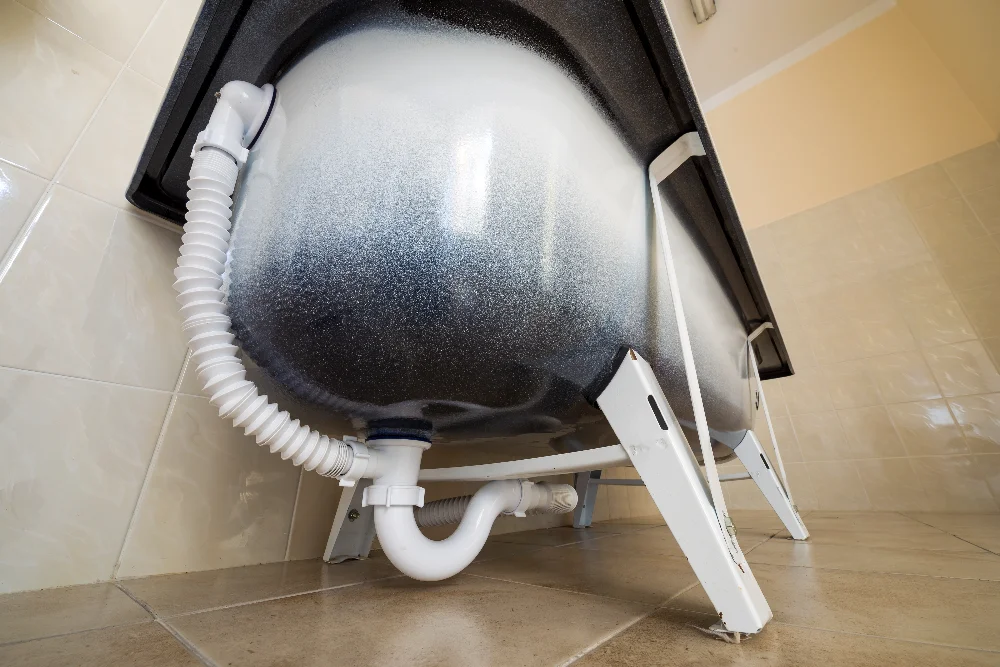Nothing puts a damper on your day like finding a leak beneath your bathtub. If you’re wondering how to fix a leaking bathtub drain, you’re not alone. It’s a prevalent problem among homeowners. Ignoring a little trickle or a continuous stream might cost you a lot of money in the long run. Let’s look at the reasons, remedies to clean drain, and how to keep ahead of future concerns.
Why Is My Bathtub Leaking?
Sometimes, the solution to why is my bathtub leaking is easier than you think. However, if little leaks are not addressed immediately, they can cause major issues.
Worn-Out Plumber's Putty or Gasket
Over time, plumber’s putty or the rubber gasket behind the drain flange may dry up or fracture. When this occurs, water seeps through the little spaces.
Loose or Corroded Drain Flange
If the drain flange becomes loose or corroded, it provides an ideal passage for water to escape. Even the slightest wobble might indicate problems.
Cracked Drainpipe or Fittings
Another reason why is my bathtub leaking might be a damaged drainpipe. Pipes that are old or fragile are prone to splitting, especially when temperatures fluctuate frequently.
Improper Installation
If the bathtub drain is not properly placed in the first place, leaks are unavoidable. Skipping stages during installation might lead to worse difficulties later.
Risks of Ignoring a Leaking Bathtub Drain
Sweeping a leaky drain under the rug is more than just wishful thinking; it’s a recipe for disaster.
Water Damage to Floors and Subflooring
Leaks might wet your flooring or the floorboards beneath the bathtub. Over time, this can result in warping, rotting, and costly repairs.
Mold and Mildew Growth
Mold and mildew thrive in damp environments. They can emit musty scents and pose health dangers to your household.
Structural Damage
Persistent leaks deteriorate wood framing and joists. Before you know it, you’re faced with thousands of dollars in structural repairs.
Increased Water Bills
Even a minor, consistent leak may gradually increase your water expenditures.
Hidden Leaks Can Escalate
Out of sight does not imply out of mind. Hidden leaks can spread undetected, causing damage to walls, ceilings, and floors.
How to Fix a Leaking Bathtub Drain
Let’s roll up our sleeves. Here’s how to fix a leaking bathtub drain step-by-step:
Inspect the Leak
First and foremost, determine the source of the leak. Fill the tub and keep an eye out for leaks or pools of water beneath.
Remove the Drain Flange
Using a drain removal tool or pliers, carefully loosen the drain flange. Take your time to avoid injuring the surrounding materials.
Check and Replace the Gasket
Once the flange is removed, examine the rubber gasket. If it’s brittle, cracked, or worn out, replace it.
Seal the Drain Properly
Depending on your desire, apply fresh plumber’s putty or silicone sealant to seal the new flange. Press the flange firmly back into place.
Test the Repair
Run some water into the tub and inspect below again. Are there no leaks? Congratulations, you’ve learned how to fix a leaking bathtub drain like a professional!

What Can I Use to Seal a Leaking Bathtub?
Selecting the appropriate sealant makes all the difference.
Plumber's Putty
This traditional material remains malleable and forms a watertight seal around the drain flange. It’s simple to apply and remove as needed.
Silicone Caulk
Silicone caulk provides a more lasting seal. It is good for regions that are constantly exposed to water, but it is more difficult to remove if repairs are required later on.
Can You Use Both Plumber's Putty and Silicone Together?
In most circumstances, choose one or the other. Mixing the two can cause neither to seal effectively. Stick to the drain manufacturer’s recommendations.
How to Prevent Future Drain Leaks
An ounce of prevention is worth a pound of cure, especially when it’s about leaks.
Regular Inspection of Caulk and Gaskets
Examine your tub’s drain and surrounding caulk at least once a year. Early detection can help you avoid costly shocks.
Don't Overtighten Components
While it may be tempting, over-tightening fittings can cause seals and pipes to fracture.
Use Proper Strainers to Minimize Buildup
Hair and debris may plug drains and strain pipes. A simple strainer may help prevent buildup and extend the life of your plumbing.
Faqs
Should I Use Teflon Tape on a Bathtub Drain?
No, Teflon tape is designed for threaded pipe connections, not bathtub drains. Use plumber’s putty or silicone for optimal sealing.
What Is the Best Sealant for a Bathtub Drain?
The plumber’s putty is best suited for metal drains. Silicone is ideal for plastics or locations that require long-term waterproofing.
Can I Use Silicone to Stop Water Leaks?
Yes, silicone caulk may efficiently seal tiny leaks, but it must be applied neatly and given adequate drying time.
Contact Trades Works NW to Fix Your Leaking Bathtub Drain
At the end of the day, DIY methods are ideal for minor leaks. However, there are situations when the leak is deeper and requires the assistance of a specialist. At Trades Works NW, we have years of expertise dealing with difficult leaks and plumbing difficulties. Do not allow a minor leak to turn into a large issue.
Contact us today or come to Trades Works NW to schedule a quick, pleasant service! We’ll restore your bathtub—and your peace of mind—in no time.
